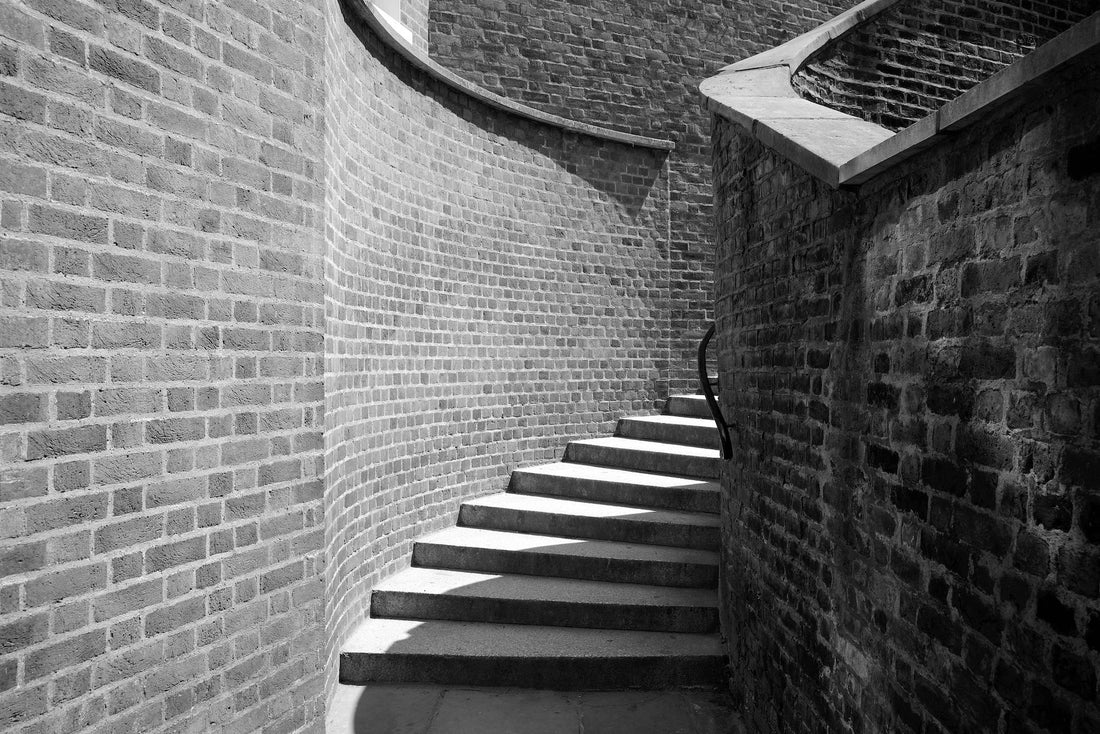
Venture down London’s alleyways with writer Matthew Turner
Share
Mapping London’s quirky alleyways for one of Blue Crow Media’s latest maps – the London Alleyways Map – is Matthew Turner, senior lecturer at Chelsea College of Arts, who has been intrigued by alleyways from a young age. Interested in how objects, spaces and whole cities can tell stories, Turner reveals some insight behind how this map came to be.
How did you become interested in alleyways? What do you like about them?
Opposite the house where I grew up there was a long alleyway. At home time, students at the high school close by would use it as a shortcut to McDonald’s, so they could drink milkshakes and throw wet paper towels at each other. I was at primary school age when I began watching them from the living room window and had that typical yearning to be grown up; I associated passing through it with coming of age and becoming a fully formed person. It was a little world within the world, a portal where after entering teenagers could gossip, sneak sips of White Lightning Cider and go ‘twos’ on cigarettes. Maybe even enjoy a first kiss. Though I didn't quite understand it at the time as I do now, it felt incredibly important and as I got closer to the age where I too could walk down there. It loomed, quite opposite to its narrow form in reality, large in my daydreams. With its associations of adolescent transcendence, it took on a kind of mythic status.
My two older sisters passed through first, then it was finally my time and the childhood urge to be more present in the world of experience was countered by the typically teenage desire to disappear. The alleyway, and those that laced the town all around it, became tracts where my friends and I could pass through life unseen by interfering adults.

Crawford Passage, London. Photography: Nigel Green
Alleyways still retain some of these characteristics for me, but now they are more moments of intensity where multiple strands of history convene to create a spatial form. By history I don’t mean something you would look at in a display case, it’s a kind of uncomplicated magical sense of the past where you can’t parse one element from the other, only feel it.
I also like, the same as desire lines (paths created by human or animal erosion), that they’re not designed. Just sculpted by the conflicting forces of the city around them; by sewers, lost rivers, property boundary disputes, bombs, collapse and dereliction. Some are even formed from ancient animal tracks, that by some quirk of the city just haven’t been built over. All these factors coagulate to give these refreshing moments of subtle chaos in a city that is becoming increasingly boring and rational.

The London Alleyways Map
Can you tell us a bit about your general interests and background?
I’m a senior lecturer at Chelsea College of Arts and I’ve been writing essays and fiction for a number of years now, with a particular interest in how objects, spaces and whole cities can tell a story. With accretions of history and myth, alleyways can be read like short stories or novels and are the same in how they change space and time.
Used as shortcuts they might get you somewhere quicker than expected, or get you lost and you’ll never quite reach where you wanted to go. Just like a passage of text takes the reader from one part of the action to the next, an alleyway in the city is a portal that can rapidly transport someone from one urban condition to a radically different place, and in the process, colour their understanding of it. Streets and roads are the main plot, but alleyways and shortcuts are its amorphous and mysterious subtext, an urban mise en abyme, a fleeting subplot within the drama of a city you may already be familiar with.
More simply than that, they can be more literally read, often containing ancient graffiti, old signs and I’ve found lots of hand-written notes—people seem to feel comfortable depositing their confessions and life stories in these intimate and secretive places. Text, however, needs to be combined with the imagination to truly come alive and, likewise, alleyways barely exist without use of the imagination. For me they are as fictional as an actual place can get.

Golden Jubilee Bridges walk, London. Photography: Nigel Green
Can you highlight three of your favourite alleyways from the map, and tell us why you are drawn to them and how you came upon them?
1. French Ordinary Court
After leaving a book launch in the basement of a church, I found this by chance while trying to shelter from a thunderstorm in what looked like a carpark. A dim light led me deeper into the space and I found a zig-zag of passages, and by the time I found my way out again the storm had stopped. Walking through here is like exploring a sequence of urban caves rather than an alleyway, and it’s always twilight, regardless of the time of day. It runs below Fenchurch Street Station, acting as a reminder that cities can grow upwards so aggressively that they make what was once street level feel like it’s been pushed underground by the weight of what’s above. To become a true Londoner we must be attuned to the city below our feet just as much as the one overhead.
2. China Wharf
My family and I always walked a lot, and it wasn't until I arrived at university in London and started to talking to people about it that I realised it was odd we walked six miles (12 miles in all) to my grandmother’s house every Sunday. I still enjoy walking now, and after a particularly long hike taking in both foot tunnels under the Thames, Greenwich and Woolwich, I came across this incredible view of the city. The narrowness of the alleyway reveals the towering expanse of glowing tower blocks theatrically, like that first view of a whole mountain range when you reach the top of a mountain. It’s best to visit this one at night.
3. Watergate Walk
I didn't really find this one because it’s always just been there waiting in the back of my mind to be included in some form of writing. Gordon’s Wine Bar is one of my favourite places in central London to eat cheese and drink wine. While the cellar bar has its French charms, it was a welcome respite from the sweat and crowds when they started letting people sit in the alleyway outside. It marks where the Thames used to reach before the construction of the Victoria Embankment, and it will probably be flooded again sometime in the not too distant future.
What was your process behind finding and researching all these alleyways in London?
Some of them I already knew from things I’d read and places I’d visited – London Alleys Byways & courts by Alan Stapleton is an excellent, if at times fanciful, book that I found useful. The other alleyways I found during some quite epic lockdown walks. I was spending a lot of time online talking to students and colleagues on Teams, and I wanted something that I could do completely offline. I bought a large and detailed map of London and attached it to a pin board, and every weekend I would simply pick a grid square and go out exploring it. When I came back in the evening I marked the alleyways I found with dress making pins and little tags so I could keep track of which one was which. After a few months the map was overrun with around 155 alleyways, and then I cut it down to 53 for the final map.

Pickering Place, London. Photography: Nigel Green
Can you suggest an afternoon itinerary for someone with the map?
Take a meandering route to the River Thames starting at Crawford Passage, go via St John’s Path, Turnagain Lane, Wine Office Court and St Bride’s Avenue. Along the way, Cafe Kick on Exmouth Market is good for a snack and an early afternoon drink, then – after not getting very far – stop for lunch at The Eagle Farringdon (their simple but unusual menu changes every day), and maybe if still hungry, Holborn Dining Room for dinner. If between those stops you’re parched or it’s raining, The Holy Tavern (formerly The Jerusalem Tavern) is adjacent to St John’s Path and is completely candlelit on Tuesdays.
This would have you roughly following the course of what was once the River Fleet – London’s most famous lost river. It’s now been covered over, but if you stand in Clerkenwell Green on quiet day it can be heard flowing under the pavement. Finish the walk at The Blackfriar for a pint of London Pride and a look at the bawdy murals – close by is where what remains of the River Fleet trickles into the Thames.

1 comment
Being a Northern I am always fascinated by the history of the unknown (to me) London. My partner and I visit regularly and I always try to find something different for us to do, but has to involve walking. This map looks like my next purchase.